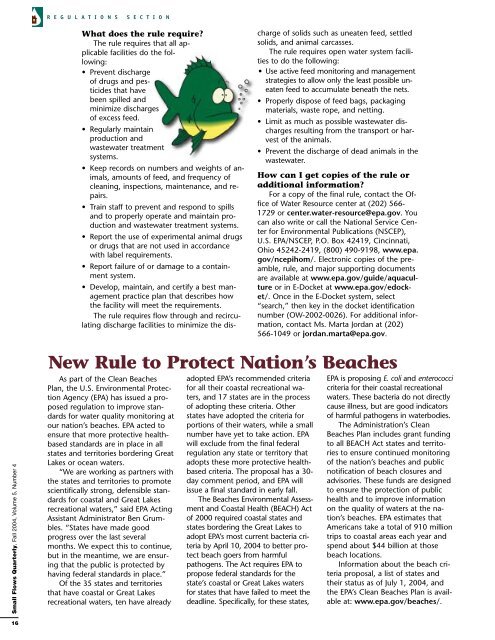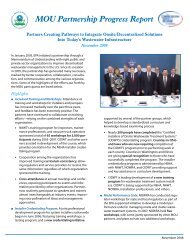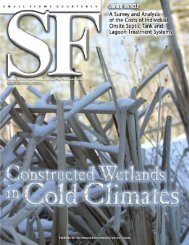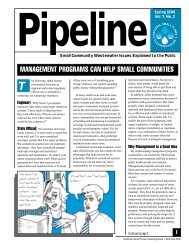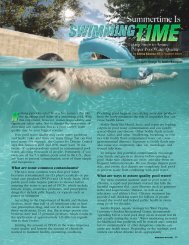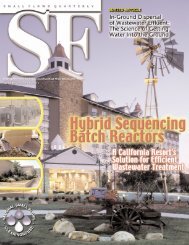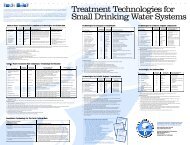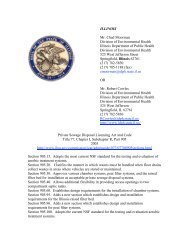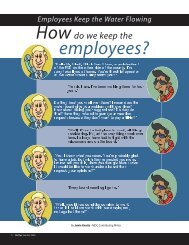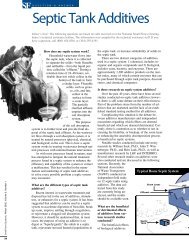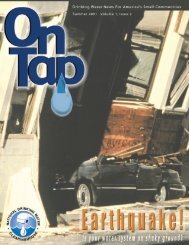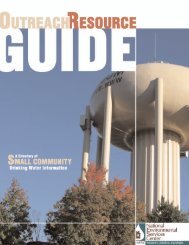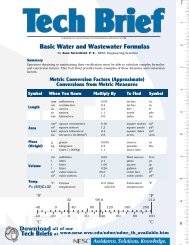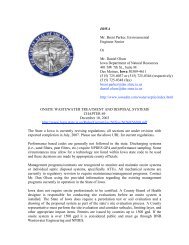Download - National Environmental Services Center - West Virginia ...
Download - National Environmental Services Center - West Virginia ...
Download - National Environmental Services Center - West Virginia ...
Create successful ePaper yourself
Turn your PDF publications into a flip-book with our unique Google optimized e-Paper software.
R E G U L A T I O N S S E C T I O N<br />
What does the rule require?<br />
The rule requires that all applicable<br />
facilities do the following:<br />
• Prevent discharge<br />
of drugs and pesticides<br />
that have<br />
been spilled and<br />
minimize discharges<br />
of excess feed.<br />
• Regularly maintain<br />
production and<br />
wastewater treatment<br />
systems.<br />
• Keep records on numbers and weights of animals,<br />
amounts of feed, and frequency of<br />
cleaning, inspections, maintenance, and repairs.<br />
• Train staff to prevent and respond to spills<br />
and to properly operate and maintain production<br />
and wastewater treatment systems.<br />
• Report the use of experimental animal drugs<br />
or drugs that are not used in accordance<br />
with label requirements.<br />
• Report failure of or damage to a containment<br />
system.<br />
• Develop, maintain, and certify a best management<br />
practice plan that describes how<br />
the facility will meet the requirements.<br />
The rule requires flow through and recirculating<br />
discharge facilities to minimize the discharge<br />
of solids such as uneaten feed, settled<br />
solids, and animal carcasses.<br />
The rule requires open water system facilities<br />
to do the following:<br />
• Use active feed monitoring and management<br />
strategies to allow only the least possible uneaten<br />
feed to accumulate beneath the nets.<br />
• Properly dispose of feed bags, packaging<br />
materials, waste rope, and netting.<br />
• Limit as much as possible wastewater discharges<br />
resulting from the transport or harvest<br />
of the animals.<br />
• Prevent the discharge of dead animals in the<br />
wastewater.<br />
How can I get copies of the rule or<br />
additional information?<br />
For a copy of the final rule, contact the Office<br />
of Water Resource center at (202) 566-<br />
1729 or center.water-resource@epa.gov. You<br />
can also write or call the <strong>National</strong> Service <strong>Center</strong><br />
for <strong>Environmental</strong> Publications (NSCEP),<br />
U.S. EPA/NSCEP, P.O. Box 42419, Cincinnati,<br />
Ohio 45242-2419, (800) 490-9198, www.epa.<br />
gov/ncepihom/. Electronic copies of the preamble,<br />
rule, and major supporting documents<br />
are available at www.epa.gov/guide/aquaculture<br />
or in E-Docket at www.epa.gov/edocket/.<br />
Once in the E-Docket system, select<br />
“search,” then key in the docket identification<br />
number (OW-2002-0026). For additional information,<br />
contact Ms. Marta Jordan at (202)<br />
566-1049 or jordan.marta@epa.gov.<br />
Small Flows Quarterly, Fall 2004, Volume 5, Number 4<br />
New Rule to Protect Nation’s Beaches<br />
As part of the Clean Beaches<br />
Plan, the U.S. <strong>Environmental</strong> Protection<br />
Agency (EPA) has issued a proposed<br />
regulation to improve standards<br />
for water quality monitoring at<br />
our nation’s beaches. EPA acted to<br />
ensure that more protective healthbased<br />
standards are in place in all<br />
states and territories bordering Great<br />
Lakes or ocean waters.<br />
“We are working as partners with<br />
the states and territories to promote<br />
scientifically strong, defensible standards<br />
for coastal and Great Lakes<br />
recreational waters,” said EPA Acting<br />
Assistant Administrator Ben Grumbles.<br />
“States have made good<br />
progress over the last several<br />
months. We expect this to continue,<br />
but in the meantime, we are ensuring<br />
that the public is protected by<br />
having federal standards in place.”<br />
Of the 35 states and territories<br />
that have coastal or Great Lakes<br />
recreational waters, ten have already<br />
adopted EPA’s recommended criteria<br />
for all their coastal recreational waters,<br />
and 17 states are in the process<br />
of adopting these criteria. Other<br />
states have adopted the criteria for<br />
portions of their waters, while a small<br />
number have yet to take action. EPA<br />
will exclude from the final federal<br />
regulation any state or territory that<br />
adopts these more protective healthbased<br />
criteria. The proposal has a 30-<br />
day comment period, and EPA will<br />
issue a final standard in early fall.<br />
The Beaches <strong>Environmental</strong> Assessment<br />
and Coastal Health (BEACH) Act<br />
of 2000 required coastal states and<br />
states bordering the Great Lakes to<br />
adopt EPA’s most current bacteria criteria<br />
by April 10, 2004 to better protect<br />
beach goers from harmful<br />
pathogens. The Act requires EPA to<br />
propose federal standards for the<br />
state’s coastal or Great Lakes waters<br />
for states that have failed to meet the<br />
deadline. Specifically, for these states,<br />
EPA is proposing E. coli and enterococci<br />
criteria for their coastal recreational<br />
waters. These bacteria do not directly<br />
cause illness, but are good indicators<br />
of harmful pathogens in waterbodies.<br />
The Administration’s Clean<br />
Beaches Plan includes grant funding<br />
to all BEACH Act states and territories<br />
to ensure continued monitoring<br />
of the nation’s beaches and public<br />
notification of beach closures and<br />
advisories. These funds are designed<br />
to ensure the protection of public<br />
health and to improve information<br />
on the quality of waters at the nation’s<br />
beaches. EPA estimates that<br />
Americans take a total of 910 million<br />
trips to coastal areas each year and<br />
spend about $44 billion at those<br />
beach locations.<br />
Information about the beach criteria<br />
proposal, a list of states and<br />
their status as of July 1, 2004, and<br />
the EPA’s Clean Beaches Plan is available<br />
at: www.epa.gov/beaches/.<br />
16


